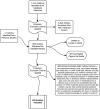Clinical and cost-effectiveness, safety and acceptability of c ommunity i ntra v enous a ntibiotic s ervice models: CIVAS systematic review
- PMID: 28428184
- PMCID: PMC5775457
- DOI: 10.1136/bmjopen-2016-013560
Clinical and cost-effectiveness, safety and acceptability of c ommunity i ntra v enous a ntibiotic s ervice models: CIVAS systematic review
Abstract
Objective: Evaluate evidence of the efficacy, safety, acceptability and cost-effectiveness of outpatient parenteral antimicrobial therapy (OPAT) models.
Design: A systematic review.
Data sources: MEDLINE, EMBASE, CINAHL, Cochrane Library, National Health Service (NHS) Economic Evaluation Database (EED), Research Papers in Economics (RePEc), Tufts Cost-Effectiveness Analysis (CEA) Registry, Health Business Elite, Health Information Management Consortium (HMIC), Web of Science Proceedings, International Pharmaceutical Abstracts, British Society for Antimicrobial Chemotherapy website. Searches were undertaken from 1993 to 2015.
Study selection: All studies, except case reports, considering adult patients or practitioners involved in the delivery of OPAT were included. Studies combining outcomes for adults and children or non-intravenous (IV) and IV antibiotic groups were excluded, as were those focused on process of delivery or clinical effectiveness of 1 antibiotic over another. Titles/abstracts were screened by 1 reviewer (20% verified). 2 authors independently screened studies for inclusion.
Results: 128 studies involving >60 000 OPAT episodes were included. 22 studies (17%) did not indicate the OPAT model used; only 29 involved a comparator (23%). There was little difference in duration of OPAT treatment compared with inpatient therapy, and overall OPAT appeared to produce superior cure/improvement rates. However, when models were considered individually, outpatient delivery appeared to be less effective, and self-administration and specialist nurse delivery more effective. Drug side effects, deaths and hospital readmissions were similar to those for inpatient treatment, but there were more line-related complications. Patient satisfaction was high, with advantages seen in being able to resume daily activities and having greater freedom and control. However, most professionals perceived challenges in providing OPAT.
Conclusions: There were no systematic differences related to the impact of OPAT on treatment duration or adverse events. However, evidence of its clinical benefit compared with traditional inpatient treatment is lacking, primarily due to the dearth of good quality comparative studies. There was high patient satisfaction with OPAT use but the few studies considering practitioner acceptability highlighted organisational and logistic barriers to its delivery.
Published by the BMJ Publishing Group Limited. For permission to use (where not already granted under a licence) please go to http://www.bmj.com/company/products-services/rights-and-licensing/.
Conflict of interest statement
Competing interests: None declared.
Figures
References
-
- Török ME, Chapman AL, Lessing MP, et al. . Outpatient parenteral antimicrobial therapy: recent developments and future prospects. Curr Opin Investig Drugs 2010;11:929–39. - PubMed
-
- Department of Health. National Health Service and Community Care Act 1990. London: The Stationary Office, 1990.
Publication types
MeSH terms
Substances
Grants and funding
LinkOut - more resources
Full Text Sources
Other Literature Sources
Medical

